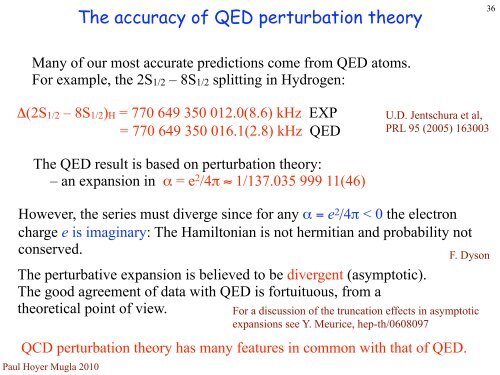Introduction to QCD slides - P.Hoyer.pdf - High Energy Physics Group
Introduction to QCD slides - P.Hoyer.pdf - High Energy Physics Group
Introduction to QCD slides - P.Hoyer.pdf - High Energy Physics Group
You also want an ePaper? Increase the reach of your titles
YUMPU automatically turns print PDFs into web optimized ePapers that Google loves.
Paul <strong>Hoyer</strong> Mugla 2010<br />
The accuracy of QED perturbation theory<br />
Many of our most accurate predictions come from QED a<strong>to</strong>ms.<br />
For example, the 2S1/2 – 8S1/2 splitting in Hydrogen:<br />
Δ(2S1/2 – 8S1/2)H = 770 649 350 012.0(8.6) kHz EXP<br />
= 770 649 350 016.1(2.8) kHz QED<br />
The QED result is based on perturbation theory:<br />
– an expansion in α = e 2 /4π ≈ 1/137.035 999 11(46)<br />
U.D. Jentschura et al,<br />
PRL 95 (2005) 163003<br />
However, the series must diverge since for any α = e2/4π < 0 the electron<br />
charge e is imaginary: The Hamil<strong>to</strong>nian is not hermitian and probability not<br />
conserved. F. Dyson<br />
The perturbative expansion is believed <strong>to</strong> be divergent (asymp<strong>to</strong>tic).<br />
The good agreement of data with QED is fortuituous, from a<br />
theoretical point of view. For a discussion of the truncation effects in asymp<strong>to</strong>tic<br />
expansions see Y. Meurice, hep-th/0608097<br />
<strong>QCD</strong> perturbation theory has many features in common with that of QED.<br />
36


